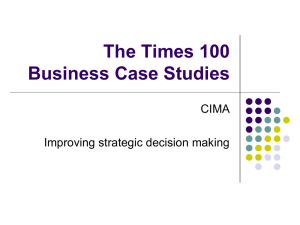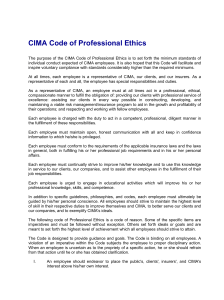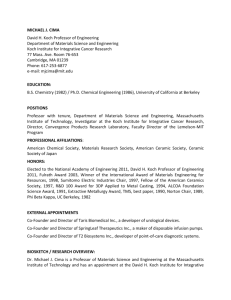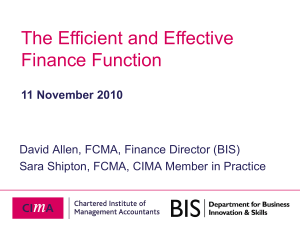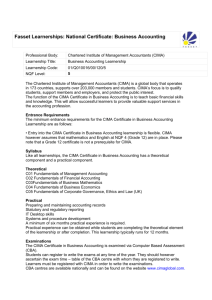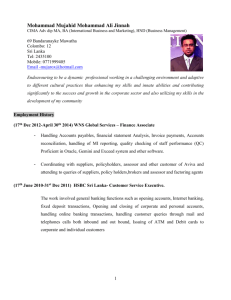CIMA P2 Course Notes Chapter 1 Relevant costs and decision making
advertisement
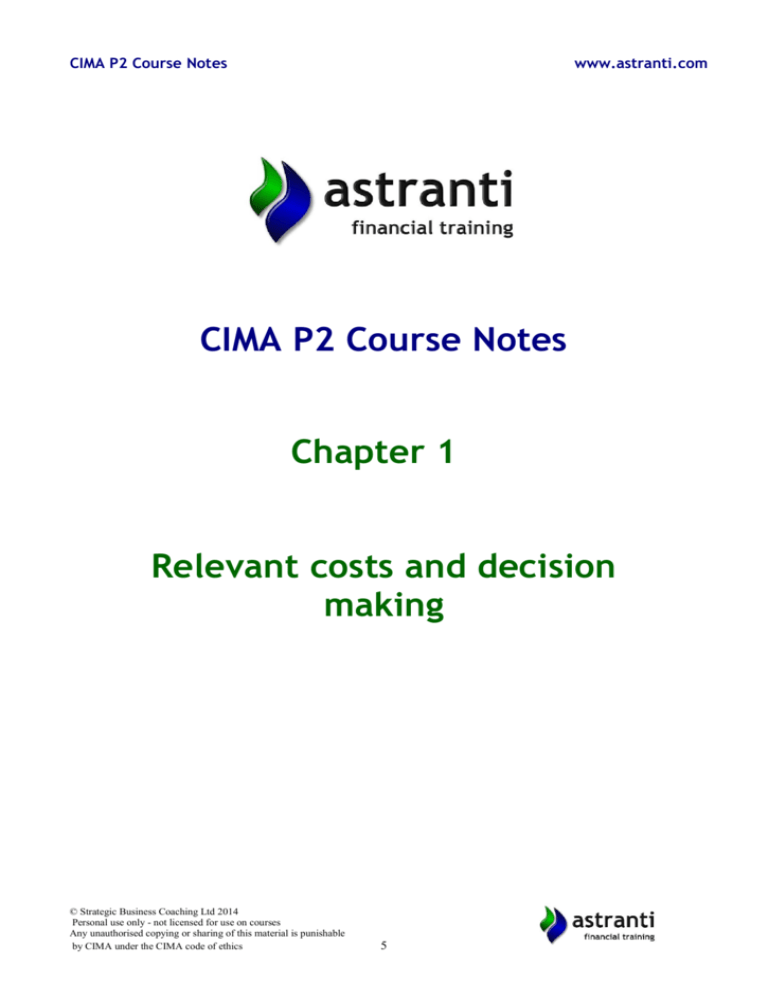
CIMA P2 Course Notes www.astranti.com CIMA P2 Course Notes Chapter 1 Relevant costs and decision making © Strategic Business Coaching Ltd 2014 Personal use only - not licensed for use on courses Any unauthorised copying or sharing of this material is punishable by CIMA under the CIMA code of ethics 5 CIMA P2 Course Notes 1. www.astranti.com Relevant costs Costs and decision making Directors and managers are constantly making investment decisions in the business. This might include decisions such as: Products to make (or not) Businesses to buy (or sell) Assets to purchase (or lease) or those to dispose of Staff to employ Resources to acquire (e.g. key materials) Such investment decisions will often be affected by a whole range of factors such as the business’ strategy, markets, competitors, profitability and, the key for us for this section, the costs. We might consider the cost of the product; can it be sold profitably? The cost of the staff; will they generate a return if employed at current market rates? The costs of material and overheads; can the finished product be sold for enough to cover those costs? The costs of the assets; are they affordable long term and will they be suitable to deliver a long term? Costs are critical to many business decisions, and they are a key focus for accountants who are responsible for recording and analysing costs, and using them to support financial decision making. Relevant Costs When making a decision it is imperative that an organisation look at all relevant costs; these are costs that will be directly affected by the outcome of the decision or have a direct effect on the decision. These will be costs that have a direct impact on the cash flow or revenue of the business. So here’s the formal definition for you – do learn this. Relevant costs are FUTURE, CASH, and INCREMENTAL costs directly arising as the result of an investment decision. Example 1 Let’s look at a simple example to introduce the concept. Let’s say you are about to purchase a car and are comparing two; Car A costs $4,000, plus $1,000 per year for the next 3 years, and Car B costs $5,000. Although the initial cost of car A is lower, the total future cashflows for it are higher, so that’s the more expensive long term. © Strategic Business Coaching Ltd 2014 Personal use only - not licensed for use on courses Any unauthorised copying or sharing of this material is punishable by CIMA under the CIMA code of ethics 6 CIMA P2 Course Notes www.astranti.com Okay that’s obvious! But what about the car we’ve currently got which we can sell for $3,000 – is that a relevant cost for our decision about whether to choose car A or B? Well in this case – no – we get the funds whichever car we buy – there is no ‘incremental cashflow’ of one option over the other, so we ignore this when decision making. This is the essence of relevant costing – making sure we consider all the ‘right costs’ relevant to the decision, ignoring those that are unaffected by it. Example 2 Let’s have a look at another example to demonstrate the point of relevant costs….. A property company has already invested £110m in a development project on a retail estate. The buildings and facilities have only been half built and will require another £100m to complete, and due to various external factors, the retail estate can now only be sold for £150m. The decision to be made is whether or not the company should invest that extra £100m? Now if we take into account all costs involved then it will give the impression that we are spending £210m to make £150m (Not a sound business strategy!) But… You must remember that the initial £110m has already been paid (what is called a sunk cost), this money cannot be reclaimed and so is not a relevant future cash flow. If we remove that initial expense the story is very different, now it is a case of spending £100m to get £150m back. If we do this project our shareholders will be £50m better off than if we don’t – that’s what’s key. Relevant costs vs financial accounting costs I’m sure by now you’ve noticed that relevant costing for decision making is quite different from costing undertaken for the purposes of financial accounting. In example 2 above, for financial accounting purposes we would need to show all historic costs in our P&L, so the total costs of the project are £210m and if sold at £150m this would produce a £60m loss. However, hopefully, through these examples, you can see that the financial accounting profit or loss is not always optimum for decision making, particularly for short term decisions or where the project is already part the way through, as in this case. Types of relevant costs There are a range of different relevant costs, and you must be aware of them all when doing relevant costing questions. Future cash flows © Strategic Business Coaching Ltd 2014 Personal use only - not licensed for use on courses Any unauthorised copying or sharing of this material is punishable by CIMA under the CIMA code of ethics 7 CIMA P2 Course Notes www.astranti.com Relevant cash flows are always related to the future and there must be an actual cash flow associated with it. For instance the purchase of new materials on a construction project are a future, relevant cash flow as without the project we would not be purchasing the material. The purchase costs of material that the company already has stored is not a relevant cash flow as this occurred in the past and the purchase was not made with this project in mind. This is a sunk cost (see below) and should be ignored for decision making purposes, as whether we undertake this project or not there are no additional costs to the business – so the original cost of this is irrelevant to the decision being made. However, what if this material however has a resale value? There is a future relevant cash flow in this case equivalent to that resale amount. If we proceed with the project we will not be able to realise that resale value and will ‘lose that income’. The relevant cost when assessing the use of that stored material is therefore the resale value. Incremental costs Any increase or decrease in future cashflows as a result of a decision is a relevant cost. For instance, staff are not always a relevant cost. Full-time employed staff working on a project would be paid whether a particular project was in place or not and so is not deemed ‘relevant’. However hiring temporary staff to work on a specific project is an incremental relevant cost of this project, so it must be included. Opportunity costs Opportunity cost is the benefit sacrificed (lost contribution) by choosing one decision over another. Example - A company has a production line for a Product. Revenues are £8 per product, costs of labour £3 and costs of materials £3.50. That gives us a contribution of £1.50 (£8 - £3 - £3.50). The company are offered a special project which will mean moving 4 skilled staff who can not be replaced and who are paid £15 per hour from the production line A to the project thereby losing 1,000 units. What is the opportunity cost of this? Solution - The staff are being paid whichever production line they are working and so there is no change in future cashflow and this cashflow is not relevant to the decision. However, 1000 units will not be produced so revenues of 1,000 × £8 will be lost, while the materials for these units will not be purchased saving 1,000 × £3.50. The opportunity cost (and relevant cost of using the labour) here then is £8,000 - £3,500 = £4,500. © Strategic Business Coaching Ltd 2014 Personal use only - not licensed for use on courses Any unauthorised copying or sharing of this material is punishable by CIMA under the CIMA code of ethics 8 CIMA P2 Course Notes www.astranti.com Avoidable costs A cost which can be avoided is relevant as it is affected by the decision being made. In the example above, the costs of materials is a good example of this. As we didn’t have to buy the materials, we avoid that cost and hence it is a relevant cost – so must be included in our calculation (as we did above). Sunk costs This cost has occurred in the past and therefore is no longer relevant as the money is already spent. A homebuyer who has had a survey done on a property before deciding if they are going to purchase it should not take the survey cost into account when making their decision. The survey cannot be undone, it is past and has happened and therefore no longer a relevant cost when evaluating whether or not to purchase the property. Committed costs A committed cost is a Future Cash flow but one which will be incurred irrespective of the decision being made and so is not relevant to the decision making process. Rental costs are often an example of committed costs. If a company is tied into a 2 year rental lease for a crane on a construction project, that cost is not relevant to the decision of whether or not to go ahead and undertake a new project that will last just a few weeks. The lease amount is committed already and can not be changed and so is not relevant to the decision. Allocated costs Costs are often allocated from another part of the business, for instance, for the use of central services. As these costs are incurred by the business as a whole irrespective of whether a project proceeds or not, they are not relevant to the decision on that project. If we consider a financial institution which needs to keep staff up to date with the latest legislation and this training is compulsory and allocated to each department, this cost will be incurred irrespective of the projects undertaken by an individual department and therefore is not relevant for their internal decision making processes such as which new product to develop. Depreciation and Amortisation © Strategic Business Coaching Ltd 2014 Personal use only - not licensed for use on courses Any unauthorised copying or sharing of this material is punishable by CIMA under the CIMA code of ethics 9 CIMA P2 Course Notes www.astranti.com As relevant costs only deal with cash flows, depreciation and amortisation are also considered irrelevant costs. They are just accounting adjustments – not cash coming in or out of the bank account. 2. Minimum pricing Relevant costing how it relates to pricing The minimum price is determined by the company taking all relevant costs into account; once these have been collected and analysed they will need to be added together, this grand total of relevant costs will be the ‘minimum price’ in that the company should not sell the product/service etc for less than this minimum price. Example Returning to our earlier example about the retail development project. You may remember we had already spent £110m, and had another £100m to spend to finish it off. The relevant costs here are £100 (the future cashflows). That’s also the minimum price we’ll need to charge to recoup future cashflows. Anything less than this and we should abandon the project. The relevant costs also give us the minimum price therefore. Further example Let’s take the same example but add a little more complexity. So far we have assumed there was no resale value for the work already completed. Let us now assume that the company could sell the half developed project to another property firm for £60m. This £60m now becomes an opportunity cost, as it is money that could be received. As we have already discussed opportunity costs are relevant costs and so MUST be considered when making a decision. So the company was in a position where it needed to invest another £100m to sell the completed project for £150m, the initial £100m has been lost BUT we now have the chance make £60m by selling the half completed project. Adding the two relevant costs together (100m + 60m) gives us what will become the minimum price: £160m. As you can see this is more than they can sell it for and so the sale of the half developed project now becomes the more attractive option UNLESS they can push the finished project buyer up beyond £160m. Minimum pricing in the real world In the real world the ‘minimum price’ is unlikely to be the final sales price because the company will want to add on a profit margin (which the minimum price does not provide), but nevertheless it provides a good start © Strategic Business Coaching Ltd 2014 Personal use only - not licensed for use on courses Any unauthorised copying or sharing of this material is punishable by CIMA under the CIMA code of ethics 10 CIMA P2 Course Notes www.astranti.com for preparing pricing and negotiation strategies as to put it simply; for every pound/dollar etc OVER the minimum price that is paid the company benefits, every pound/dollar etc UNDER the company loses out. 3. To produce or to purchase? A decision that most companies will have to make at some point is whether or not certain components, products or services required to make their product should be made within the organisation or bought in from an external supplier. There are both financial and non-financial factors which can influence this decision; let’s look at each in turn. Financial considerations Ultimately for a company looking to perform as well as possible the cost is a huge factor, the company must assess all RELEVANT costs for both the option to make the product or buy the product. Example Company D needs 10,000 engines for the cars they are producing; they can either buy these in or make them themselves. Here are the traditional costs for making the product internally. Per Unit (£) Total (£) Material 200 2,000,000 Labour 100 1,000,000 Applied Variable Costs 100 1,000,000 Total 400 4,000,000 In the above example we can see that it costs the company £400 per engine to make, however they could in fact buy the engines from a supplier at a cost of £420 per unit. Making seems to be the best option. However, let’s say that if we buy in the engines we can use the staff and facilities to produce another product which gives us a contribution of £50. The decision then changes completely as have to compare all relevant costs to see whether or not this is the best course of action to take: Purchase price Material Labour Per Unit Produce Purchase £420 £200 £100 © Strategic Business Coaching Ltd 2014 Personal use only - not licensed for use on courses Any unauthorised copying or sharing of this material is punishable by CIMA under the CIMA code of ethics 11 Total Produce Purchase £4,200,000 £2,000,000 £1,000,000 CIMA P2 Course Notes Applied Variable Costs Opportunity Cost Total Relevant Costs Difference www.astranti.com £100 £50 £450 £420 £30 £1,000,000 £500,000 £4,500,000 £4,200,000 £300,000 As you can see here the additional cost incurred by tying up your limited capacity machines in producing the engines ultimately means that it is more expensive to produce than purchase, this is another example of the importance of relevant costs. Non-financial considerations In addition to the obvious financial implications there are several other less tangible factors that ultimately need to be considered before a decision can be made: Strategic importance – How important is the product in question to the business and its competitive advantage? If it is imperative then it should not be outsourced in any way and instead kept completely in-house. Google are unlikely to outsource the development of their web search development – this is a key element to their success that they must retain in-house. Likewise if it is a generic component that can be bought anywhere it may be more efficient to buy from a supplier e.g. nuts and bolts. Quality – Quality is obviously important to any business and so a company must assess this when deciding whether to produce or purchase; by producing you can have more of a control over the exact level of quality but a supplier who specialises in producing the required item may produce a far superior product. Reliability – A risk that is always taken when purchasing from an external supplier is relying on their ability to meet your demands, a supplier may produce a component at a rate far cheaper and to a much higher quality standard than you can but if you cannot rely on them to produce in the quantities you need or to deliver them on time then they are not a suitable option. 4. Limiting Factors As the name would suggest, these are factors that ultimately limit the amount of produce that can be made by a company within a certain period. For example, you want to make and sell 20,000 products a month but your machine capacity is completely maxed out at 15,000 products, in this instance machine capacity is a ‘limiting factor’ in production. © Strategic Business Coaching Ltd 2014 Personal use only - not licensed for use on courses Any unauthorised copying or sharing of this material is punishable by CIMA under the CIMA code of ethics 12 CIMA P2 Course Notes www.astranti.com Single limiting factor This occurs when a company’s production is stifled and limited by a single factor. The machine in the example above is an example of a single limiting factor. In this case a decision then has to be made by the powers that be at the company on how to mitigate the effects of this limitation by using it in the most efficient way. Another great example of this would be raw materials; if a supplier can only grant you a finite amount of material and that material is used in all the different products you produce, you must figure out the most efficient and profit maximising use for it. This is particularly relevant as this is often the example chosen to be tested in exam questions. For example a company produces products A, B and C and relies on a supplier to provide materials X and Y to produce them. However, the supplier can only provide a finite amount of X and Y. With the exception of external demand the rest of the company’s production is uninhibited by any other factors so this restriction on supply is the ‘single limiting factor’. The supplier can provide 2000 tonnes of both products X and Y, usage of this material in each product can be seen below: A 1 6 150 75 Quantity required X (Tonnes) Quantity required Y (Tonnes) Sales demand (Max) Contribution per unit (£) B 2 5 100 100 C 3 4 200 60 Step 1 is to see whether or not the amount of X and Y that can be obtained will be sufficient; it could be that there is enough of one material for period but not enough of the other. Sales demand (Max) Material X per unit Total material X Material Y per unit Total material Y A 150 1 150 6 900 B 100 2 200 5 500 C 200 3 600 4 800 Total 950 2200 As you can see, there is more than enough of material X to fulfil the period’s production but not enough of material Y. So the question now is where you allocate the limited quantity of material Y in order to get the most efficient return? Step 2: The next step is to take a look at the contribution per unit and contrast it against the amount of material required for each product: © Strategic Business Coaching Ltd 2014 Personal use only - not licensed for use on courses Any unauthorised copying or sharing of this material is punishable by CIMA under the CIMA code of ethics 13 CIMA P2 Course Notes www.astranti.com A B C Contribution per unit (£) 75 100 60 Quantity required Y (Tonnes) 6 5 4 Contribution per tonne (£) 12.5 20 15 Now the contribution per tonne has been calculated we can rank the products by their rate of return by usage of material Y, in this example from highest to lowest would be B, C, A. Note what we’re doing here – we’re saying that per tonnes of this limited material, on what do we get the best return. Step 3: With this knowledge we can then allocate material Y accordingly, ensuring that the maximum number of product B is produced before allocating any of our material Y stock to product C and so on, ensuring the best possible return from the limited amount of raw material: Product Recommended production (Units) Material Y used (Tonnes) B 100 500 C 200 116 (700÷6) (Note the 700 is what is left after B and C are completed) 800 A Total 700 2000 With material Y priority being given in accordance with contribution per tonne, the company can make the best use out of its limiting factor. 5. Joint costs Joint cost and process situations often arise as the result of different products being created out of the same resources. In oil refining, the main products which are produced from this are fuel oil, diesel, kerosene, petrol, butane and propane. The costs which go into drilling the oil and refining it, now need to be split in a fair way between the various outputs from the process. This is the essence of joint costing. It is important to accurately apportion costs of each joint product to properly value stock, monitor costs, and help decide on pricing - if one product is valued at significantly more than another, then a higher price should be charged for it. It will also be useful to identify products that are simply not contributing and assess whether or not they can be taken out of production. © Strategic Business Coaching Ltd 2014 Personal use only - not licensed for use on courses Any unauthorised copying or sharing of this material is punishable by CIMA under the CIMA code of ethics 14 CIMA P2 Course Notes www.astranti.com Allocation of joint costs Joint costs are often apportioned amongst the various products involved in the production in one of the three following forms: Relative sales value – The expected sales price determines the amount of common process cost it should absorb. If petrol sold for £1 per litre and diesel £0.90 then you would apportion slightly higher costs to petrol to take into account its higher value. Net realisable value – How much the product is worth when we sell it less any future costs. This is normally calculated using the expected selling price minus any further production or selling costs. For petrol and diesel for instance we might need to take off delivery costs to find the net realisable value. Physical quantity – How much output is produced is the key here. In oil refining about 47% of output is petrol, diesel 20% while just 8% is kerosene, so costs would be apportioned in those proportions. Losses Sometimes during the process some units can be lost – through evaporation for instance. The apportionment of joint costs needs to take this into account and it is often calculated using the following formula: Output cost per unit = (Input costs – scrap value of loss) (Input units – units lost) Example Company ABC makes two products V and W, both are made using the exact same process and are both sellable at the end of this process, but they also can be improved with some product specific post-production care that can increase the selling price. The following table contains the relevant facts and figures: Volume Value Material Labour Overheads Total 10,000 £60,000 £40,000 10,000 £30,000 £130,000 Units lost Product V Product W 1,000 0 4,000 5,000 £50,000 £80,000 © Strategic Business Coaching Ltd 2014 Personal use only - not licensed for use on courses Any unauthorised copying or sharing of this material is punishable by CIMA under the CIMA code of ethics 15 CIMA P2 Course Notes www.astranti.com Total 10,000 £130,000 Product V Selling price after common process £15 Selling price after post –production processing £18 Variable cost per unit for post – production process £2.5 Product W £20 £22 £3 This information can now be used to help answer common questions on this subject: 1) Is post – production worth it individually? 2) Is post-production worth it if it is an all or nothing decision (i.e. either both products are post-processed or neither)? Question 1 – Is post-production worthwhile We can work this out by calculating the net realisable value of each product: This is done by simply deducting the variable cost for post production from the expected selling price post production, if this Net Realisable Value (NRV) is higher than what it could be sold for now it is worth it, if it is lower it is not! Product V: NRV = 18 – 2.5 NRV = 15.5 15.5 – 15 = 0.5 Product V is worth more when it has been undergone post production therefore it is worth it. Product W: NRV = 22 – 3 NRV = 19 19 – 20 = (1) Product W on the other hand is worth more at the end of the common process, so it is not worth the extra production. © Strategic Business Coaching Ltd 2014 Personal use only - not licensed for use on courses Any unauthorised copying or sharing of this material is punishable by CIMA under the CIMA code of ethics 16 CIMA P2 Course Notes www.astranti.com Question 2 – Post production absorbed To determine whether or not post production should come as standard and if it should be absorbed jointly we need to compare the profit/loss achieved under each scenario: Goods sold at end of joint process: Product V = 4,000 × 15 = 60,000 Product W = 5,000 × 20 = 100,000 Common costs = (130,000) Profit/loss = 30,000 Goods sold at the end of post production if both must be further processed together: Product V = 4000 × 18 = 72,000 Product W = 5000 × 22 = 110,000 Common costs = (130,000) Variable costs product V = 4,000 × 2.5 = (10,000) Variable costs product W = 5,000 × 3 = (15,000) Profit/loss = 27,000 Difference = (3,000) As you can see, by producing all products to post production standard and absorbing the cost would actually cause the company to lose £3,000 over the same volume of production. So it is best that the company continues charging joint costs and the joint process rate. 6. Marginal Costing and Pricing Marginal costing Marginal costing is a method that values inventory at its variable production cost only. Fixed production costs are not included in the cost of each object and are simply written off in full against profit at the end of the period. This is useful, as we know the amount we need to sell new units at in order to cover all variable costs. Often the marginal cost is also the revelant cost so this can be very useful in short term decision making, by pricing a product at a price higher than its variable costs you will be ensuring a positive short term cashflow of your business. © Strategic Business Coaching Ltd 2014 Personal use only - not licensed for use on courses Any unauthorised copying or sharing of this material is punishable by CIMA under the CIMA code of ethics 17 CIMA P2 Course Notes www.astranti.com However marginal pricing does not fully take into account fixed costs which ultimately will have to be paid off in the long run for the business to be sustainable. Example A company makes toy planes at volumes of 200,000 a year; they also pay £200,000 in salaries to their directors and managers and £1,000,000 rent per annum on the factory. The variable production cost per unit is £10 (Variable production costs would be £2,000,000) therefore the minimum price should be anything over £10. However, if a client were to offer £14 for every unit you produce it would seem like a good offer and may very well be in the short term as you are selling your products for more than you are making for. However with the addition of fixed costs your yearly expenditure is actually £3,500,000 which to cover would mean selling the products at £17.5; this is the problem with marginal pricing- it’s good for short term decision making but not so good in the long term. 7. Intangible and non-financial factors in decision making We must remember that in the real world it’s not just the financial results that are important – there are other considerations in decision making too. A key product could be sold at below the ‘minimum price’ us accountant’s have calculated using our relevant costing models in order to gain a foothold in a new market, or to help fight off competition. These factors may include but are not limited to: Employees – Yes taking that order for additional units above capacity may be financially rewarding for the company, but how are your employees going to react to the additional work? Will you have to bring in more employees or offer more incentives to your current workforce? Competitors – How will your competitors react to anything you do? If their reaction will be as strong as to steal more market share than your new plan gains, will it really be worthwhile? Government – Will government regulations both present and future have an impact on your business and operations? These need not be financial (tax or tariffs etc). For example in the UK, there is talk of government bodies setting new guidelines on the amount of sugar that should be consumed in any one day. Now if your product contains a large amount of sugar this may have a huge impact on demand for your product despite not being a directly financial factor it may affect your revenue in the long run. © Strategic Business Coaching Ltd 2014 Personal use only - not licensed for use on courses Any unauthorised copying or sharing of this material is punishable by CIMA under the CIMA code of ethics 18 CIMA P2 Course Notes www.astranti.com Business strategy – This business will have a long term plan for it’s competitiveness. This might, for example, include making losses in the short term for long term gain. © Strategic Business Coaching Ltd 2014 Personal use only - not licensed for use on courses Any unauthorised copying or sharing of this material is punishable by CIMA under the CIMA code of ethics 19 CIMA P2 Course Notes www.astranti.com Free Study Texts Free, high quality and concise online Study Texts for all subjects Study Text also available as a book on Amazon, and ebook for download on Amazon and the iBookstore Objective Test Question Packs Objective tests linked to the Study Texts on a chapter by chapter basis – practise CIMA exam style questions as you complete each chapter of the text Mock Exam Objective Tests Mock Exams Tests designed to emulate the 2015 CIMA exams Perfect exam practise! Video Tuition Guides Comprehensive online tuition videos teaching you the full exam syllabus in a clear, concise and understandable manner Case Study Exam Courses Join our online courses for the operational, managerial and strategic case study exams including: 2 Full Day Interactive online Masterclasses to support and focus your study Full course notes Course videos – You full guide to passing the case study exams Exam technique video guide – designed to maximise your marks Video analysis of the latest Preseen Case Study 3 full, computer-based mock exams based around the latest preseen and designed to emulate the real CIMA computer exams Marking and with detailed feedback from our team of experienced markers Student forum so our expert case study teams can answer all your questions All with our unique pass guarantee scheme Or buy any element of the course individually – it's up to you! Find out more at www.astranti.com © Strategic Business Coaching Ltd 2014 Personal use only - not licensed for use on courses Any unauthorised copying or sharing of this material is punishable by CIMA under the CIMA code of ethics 20
